|
|
|
Sort Order |
|
|
|
Items / Page
|
|
|
|
|
|
|
| Srl | Item |
| 1 |
ID:
064549


|
|
|
| 2 |
ID:
060054
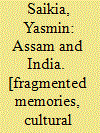

|
|
|
|
|
| Publication |
DelhI, Permanent Black, 2005.
|
| Description |
xv, 327p.hbk
|
| Standard Number |
8178241234
|
|
|
|
|
|
|
|
|
|
|
|
Copies: C:1/I:0,R:0,Q:0
Circulation
| Accession# | Call# | Current Location | Status | Policy | Location |
| 049365 | 954.16200495919/SAI 049365 | Main | On Shelf | General | |
|
|
|
|
| 3 |
ID:
077208
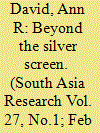

|
|
|
|
|
| Publication |
2007.
|
| Summary/Abstract |
This article first highlights the relative paucity of literature on South Asian dance and provides a brief overview of existing material. It then examines particularly the influence of filmi or Bollywood dance on South Asian dance practices in the UK. It locates film dance within the Bollywood genre, noting its recent acceptance as a new form of popular culture and its attractions for the younger generation of British Asians. The place of dance in Hindi films is analysed and discussed briefly to con-textualise the relationship between such film dances and South Asian dance practices in Britain. Using evidence from fieldwork gathered in Leicester and London amongst dance teachers and students of South Asian dance, the article questions notions of identity, authenticity, tradition and the changing nature of dance transmission as Bollywood forms grow in popularity.
|
|
|
|
|
|
|
|
|
|
|
|
|
|
|
|
| 4 |
ID:
108900
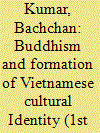

|
|
|
| 5 |
ID:
126930
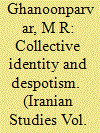

|
|
|
|
|
| Publication |
2013.
|
| Summary/Abstract |
With an overview of identity as a dominant theme in Bahram Beyzaie's artistic creations, this article examines two of his, arguably, most political plays: Chahar Sanduq (Four Boxes, 1967) and Khaterat-e Honarpisheh-ye Naqsh-e Dovvom (Memoirs of the Actor in a Supporting Role, 1981) to examine his reflections on the nature, function, and vulnerability of collective social, political, and cultural identity in authoritarian societies. Both plays illustrate that the tyrannical rulers of such societies perpetuate their dominance over their subjects through exploiting the individual's self-interests, thereby isolating him and stripping him of collective and, inevitably, individual identity. Beyzaie's allegorical and rather abstract approach in these plays contributes to conveying a less topical, culture-specific, and more universal message.
|
|
|
|
|
|
|
|
|
|
|
|
|
|
|
|
| 6 |
ID:
127043


|
|
|
| 7 |
ID:
161152
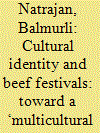

|
|
|
|
|
| Summary/Abstract |
Beef festivals are a dramatic and visible form of protest against the Indian government's ban on beef. These festivals are framed popularly as an assertion of Dalit ‘cultural rights’ and identity, with beef represented as the cultural food of Dalits. While it is clear that the beef ban is a casteist ban based on a Brahmanical food hierarchy, this paper explores the limits of resisting casteism through the assertion of caste-based cultural rights and identities, or as an assertion of an individual right to food choice. It argues that such a politics of resisting casteism runs into problems of the culturalization of caste, and limits the kinds of radical Dalit subjects and actors who could emerge as liberatory political subjects. The paper calls for reframing beef festivals as ‘antagonistic’ moments that articulate the degradation of Dalit labor in the politics of beef, reassert Dalit identity as an anti-caste identity rather than a cultural caste identity, and herald a politics of ‘multiculturalism against caste’.
|
|
|
|
|
|
|
|
|
|
|
|
|
|
|
|
| 8 |
ID:
132324
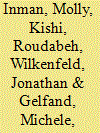

|
|
|
|
|
| Publication |
2014.
|
| Summary/Abstract |
In order to assess the impact of culture on state behavior in international crises, specifically with regard to mediation and its outcome, this study tests hypotheses rooted in both the international relations and the cross-cultural psychology literatures, implementing analysis at both the international-system level and the domestic-state-actor level. At the international system level, the study finds that cultural difference between adversaries affects whether or not mediation occurs during an international crisis but has no effect on tension reduction. At the domestic state actor level, we find that there are certain facets of cultural identity that make a state more or less open to requesting or accepting third-party mediation during an international crisis, but that these facets have no effect on tension reduction.
|
|
|
|
|
|
|
|
|
|
|
|
|
|
|
|
| 9 |
ID:
101301


|
|
|
|
|
| Publication |
2010.
|
| Summary/Abstract |
With the diffusion of networked media like the Internet, Kyrgyz youth are increasingly growing up in a world that is marked by a mix of the local and the global. With the Internet come vast, searchable, global databases, as well as a potential repositioning of users as receivers and producers of content on global networks. Media and cultural studies scholars argue that this change can unsettle social relations and lead to new ways of structuring identities. In this view, emergent identities seem to be more fluid, more unpredictable, and much less dependent on tradition. Using ethnographic techniques, this study brings to light the interaction between cultural identity and Internet use in the everyday lives of urban Kyrgyz youth. The study finds that Kyrgyz youth - catalysed by their ability to carry out searches and to maintain social connections online - are placing their cultural inheritance in a global context and questioning 'tradition' as few Kyrgyz have done before. Emergent cultural identities are not necessarily 'traditionally' Kyrgyz, nor are they global, Western or 'Russified'. Instead, youth identities are idiosyncratically local and uniquely 'in between'.
|
|
|
|
|
|
|
|
|
|
|
|
|
|
|
|
| 10 |
ID:
185333


|
|
|
|
|
| Summary/Abstract |
This article reports on data collected from the online community forums of four Uyghur language websites between 2014–2016. These posts are representative of a moment in time in which the Uyghur cultural identity was being threatened by increasingly restrictive Chinese government policies. Concept coding was applied to online discussion posts and comments, through which we identified common ideas and ‘concepts’ from the emergent themes. Findings demonstrate how these Uyghur language websites served as a platform for an online community to negotiate their cultural identity and strengthen community ties. Uyghur individuals posted materials that built cultural knowledge, reinforced cultural pride, and encouraged community cultural support.
|
|
|
|
|
|
|
|
|
|
|
|
|
|
|
|
| 11 |
ID:
129842
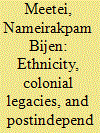

|
|
|
|
|
| Publication |
2014.
|
| Summary/Abstract |
The idea of indigenousness has been evoked to legitimize group exclusive claims including separate territories in North-East India. By analyzing experiences in Meghalaya and Manipur, the article argues that the colonial ethnic categorization that produced "ethnic conglomerates" has generated a number of problems leading to conflict in the postindependence period. First, certain composite identities have been formed by bringing together under a single umbrella a range of distinct indigenous groups' identity, often leading to the suppression of smaller identities within the larger group. Thus, the smaller groups struggle to have their own identities recognized. Furthermore, the imposed ethnic categorization has enabled the contemporary political class, which has simply perpetuated the colonial system, to use cultural identity and "indigenousness" instrumentally to their own advantage.
|
|
|
|
|
|
|
|
|
|
|
|
|
|
|
|
| 12 |
ID:
114781


|
|
|
|
|
| Publication |
2012.
|
| Summary/Abstract |
The global flow of capital, goods, people, and ideas has become ever more diverse and are affecting not only China but countries all over the world. The proverbial "other" has become increasingly present, diverse and influential in China, be it in the form of representations of destination regions for Chinese sojourners and migrants or in the form of personal experiences, given the growing numbers and higher concentrations of foreigners from around the world who have chosen to settle or conduct business in Chinese cities.
|
|
|
|
|
|
|
|
|
|
|
|
|
|
|
|
| 13 |
ID:
052795
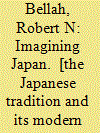

|
|
|
|
|
| Publication |
Berkeley, University of California Press, 2003.
|
| Description |
253p.hbk
|
| Standard Number |
0520235207
|
|
|
|
|
|
|
|
|
|
|
|
Copies: C:1/I:0,R:0,Q:0
Circulation
| Accession# | Call# | Current Location | Status | Policy | Location |
| 048347 | 952.03/BEL 048347 | Main | On Shelf | General | |
|
|
|
|
| 14 |
ID:
185179
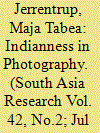

|
|
|
|
|
| Summary/Abstract |
This article explores the question whether there is a specifically Indian style of photography. A survey of photography students from various institutions revealed that though there is little clarity about the actual look of an Indian style of photography, students clearly define their own photographs as Indian. Intriguingly, the focus is less on certain visual characteristics, but more on the feelings they derive from the photographs, a scenario which is reminiscent of the rasa theory. Even though this was hardly mentioned by the students, this psycho-social element seems to have left a cultural imprint but also reflects an act of claiming ownership and agency. In addition, the students identified alienating aspects in photography, such as seeing one’s own culture like an outsider, but at the same time consider it to be integrating, since photography paves the way for a deeper engagement with one’s own culture, and as such strengthens Indianness.
|
|
|
|
|
|
|
|
|
|
|
|
|
|
|
|
| 15 |
ID:
139049
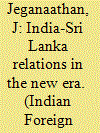

|
|
|
|
|
| Summary/Abstract |
There is no doubt that the Modi government is much more assertive and very articulate of its regional interests as compared to the previous government. It has clearly indicated that India would play a leadership role in South Asia, with less interference but more involvement in the development sectors in its neighbouring countries. It wants to make its footprint stronger in the economic development of neighbouring countries. This is not necessarily only to contain China’s aggressive inroads; rather, it is to expand both its shrinking markets as well as its cultural identity. The ‘SAARC Yatra’ by the new Foreign Secretary is an innovative strategy adopted by the MEA to strengthen India’s role in the neighbourhood. With its new leaderships, both India and Sri Lanka should take a fresh look at each other; and it is high time they take the bilateral relationship between the two countries to the next phase.
|
|
|
|
|
|
|
|
|
|
|
|
|
|
|
|
| 16 |
ID:
152616


|
|
|
|
|
| Summary/Abstract |
JNU Library will be named on Ambedkar. This decision has been taken by the highest body of the University that is the Executive Council. For the last few months the Akhil Bhartiye Bidhyarthi Parishad was demanding that Library should be named on Ambedkar. This is irony that left and radical left wing organizations believe that Ambedkar is merely the leader of Dalits.
|
|
|
|
|
|
|
|
|
|
|
|
|
|
|
|
| 17 |
ID:
151717
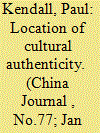

|
|
|
|
|
| Summary/Abstract |
This article examines notions of cultural identity and authenticity and how these notions are articulated in the small city of Kaili in Guizhou Province, an ethnically diverse region. Despite its urban status, Kaili has been branded by the local government as a yuanshengtai tourist destination. This Chinese term literally translates as “original ecology” but is used in ordinary conversation to denote a cultural authenticity in which people exist in quiet harmony with nature. Promotional literature uses the term to tout the ethnic cultural practices that mainly occur in the villages of Kaili’s municipal periphery. In contrast, many local urban inhabitants—although amenable to the promotion of Kaili as a tourist destination—have rejected the notion that the city itself could be considered culturally authentic, and proudly declare themselves “fake” ethnic minorities, as against the “genuine” ethnic people of surrounding villages. These small-city inhabitants have also defined themselves against big-city visitors by attributing to the visitors a naïve fascination with cultural authenticity, while themselves remaining aloof from such practices. The cultural authenticity discourse in Kaili has thus facilitated a reordering of social and spatial hierarchies, as blasé small-city residents define themselves against both culturally authentic rural people and authenticity-seeking big-city tourists. In analyzing this, the article draws out the broader implications regarding PRC notions of ethnicity, cultural practices, heritage, and identity.
|
|
|
|
|
|
|
|
|
|
|
|
|
|
|
|
| 18 |
ID:
179285
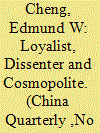

|
|
|
|
|
| Summary/Abstract |
This paper surveys the process of discursive contestation by intellectual agents in Hong Kong that fostered a counter-public sphere in China's offshore. In the post-war era, Chinese exiled intellectuals leveraged the colony's geopolitical ambiguity and created a displaced community of loyalists/dissenters that supported independent publishing venues and engaged in the cultural front. By the 1970s, homegrown and left-wing intellectuals had constructed a hybrid identity to articulate their physical proximity to, yet social distance from, the Chinese nation-state, as well as to appropriate their sense of belonging to the city-state, through confronting social injustice. In examining periodicals and interviewing public intellectuals, I propose that this counter-public sphere was defined first by its alternative voice, which contested various official discourses, second by its multifaceted inclusiveness, which accommodated diverse worldviews and subjectivities, and third by its critical platform, which nurtured social activism in undemocratic Chinese societies. I differentiate the permissive conditions that loosened constraints on intellectual agencies from the productive conditions that account for their penetration and diffusion. Habermas's idealized public sphere framework is revisited by bringing in ideational contestation, social configuration and cultural identity.
|
|
|
|
|
|
|
|
|
|
|
|
|
|
|
|
| 19 |
ID:
131771
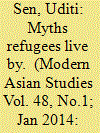

|
|
|
|
|
| Publication |
2014.
|
| Summary/Abstract |
Within the popular memory of the partition of India, the division of Bengal continues to evoke themes of political rupture, social tragedy, and nostalgia. The refugees or, more broadly speaking, Hindu migrants from East Bengal, are often the central agents of such narratives. This paper explores how the scholarship on East Bengali refugees portrays them either as hapless and passive victims of the regime of rehabilitation, which was designed to integrate refugees into the socio-economic fabric of India, or eulogizes them as heroic protagonists who successfully battled overwhelming adversity to wrest resettlement from a reluctant state. This split image of the Bengali refugee as both victim and victor obscures the complex nature of refugee agency. Through a case-study of the foundation and development of Bijoygarh colony, an illegal settlement of refugee-squatters on the outskirts of Calcutta, this paper will argue that refugee agency in post-partition West Bengal was inevitably moulded by social status and cultural capital. However, the collective memory of the establishment of squatters' colonies systematically ignores the role of caste and class affiliations in fracturing the refugee experience. Instead, it retells the refugees' quest for rehabilitation along the mythic trope of heroic and masculine struggle. This paper interrogates refugee reminiscences to illuminate their erasures and silences, delineating the mythic structure common to both popular and academic refugee histories and exploring its significance in constructing a specific cultural identity for Bengali refugees.
|
|
|
|
|
|
|
|
|
|
|
|
|
|
|
|
| 20 |
ID:
131800


|
|
|
|
|
| Publication |
2014.
|
| Summary/Abstract |
This paper attempts to revise aspects of the existing interpretations of Nie Hai Hua (A Flower in a Sinful Sea) by applying perspectives from post-colonial studies to the study of this late Qing Chinese novel. Here the novel is read as a national narrative that portrays the emergence of China as a modern nation state from a decaying empire, with its intelligentsia caught between their desire to embrace modernity and nostalgia for cultural traditions. From the mid-nineteenth century to the early twentieth century, traditional Chinese scholars were faced with a predicament: they were lured by the modernity represented by Western learning, on the one hand, but were tied by an emotional link to Chinese tradition, on the other. In a disintegrating society, they struggled both to preserve their own cultural identity and construct a new identity. The opposing groups of Chinese literati portrayed in the novel in fact reflect the schizophrenic state of the Chinese consciousness on the threshold of modernity.
|
|
|
|
|
|
|
|
|
|
|
|
|
|
|
|
|
|
|
|
|